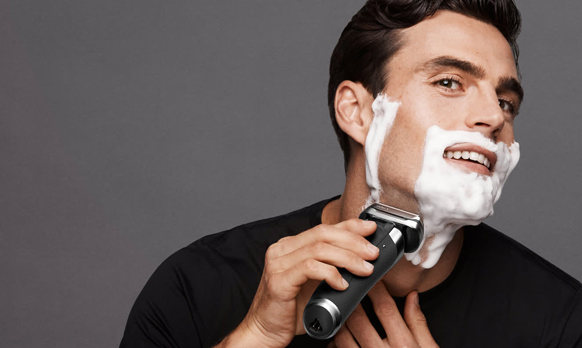Wait a moment… Have you ever wondered about the origins of shaving and how it came about? It appears that the seemingly never-ending trend of men shaving undoubtedly became popular in the 1900s, a reason that was primarily due to requirements imposed on soldiers during World War I. Exclusively important for the then-heroes who were courageously bold enough to fight in the military, they had to shave their hair so that gas masks could fit properly and provide maximum protection against harsh and unsettling chemical warfare hazards. Hmm..it must have been tough on those guys. I just can’t imagine what it felt like then. Well, that’s by the way.
You’ll agree with me that nowadays things have greatly and interestingly turned for all of us, whether you are a man or a woman. Soldiers and war heroes are not the only people who have to bother about shaving their hair. Let’s face it: You can skip several weird and overly annoying tasks if you are graced with the privilege without affecting your life. But do you know that a handful of others are crucial if you want to feel confident when out in public? I believe that shaving is one of the extremely important (if not necessary) tasks that will undoubtedly boost your ego in public. Believe it or not, that’s the truth!
 For your information, shaving has been a practice for centuries and is commonly used to remove hair from both small areas. Now, I’m not going to speak in favor of any gender and my reason is simple—shaving is for both genders. It’s not difficult to guess after all, is it? This worldwide hair removal process involves using a razor or another sharp tool to trim the hair at the skin’s surface. Regarding self-care, men have always considered shaving as part of their routine. Similarly, in my opinion, women have also embraced shaving to remove hair from areas like underarms, legs, and intimate regions. In all, it’s safe to say that shaving is significant for both men and women.
For your information, shaving has been a practice for centuries and is commonly used to remove hair from both small areas. Now, I’m not going to speak in favor of any gender and my reason is simple—shaving is for both genders. It’s not difficult to guess after all, is it? This worldwide hair removal process involves using a razor or another sharp tool to trim the hair at the skin’s surface. Regarding self-care, men have always considered shaving as part of their routine. Similarly, in my opinion, women have also embraced shaving to remove hair from areas like underarms, legs, and intimate regions. In all, it’s safe to say that shaving is significant for both men and women.
But do you know what the major problem is? I guess it is getting to know and understand the best shaving for your body type. That brings us to the big question: Which is better for you, wet shaving vs. dry shaving? This is a million-dollar question.
Journey with me as we discuss better shaving for your body type.
Table of Contents:
Wet Shaving vs. Dry Shaving
Do you know what the big question is? Well, let’s begin with the definition of some terms. In this age, we are lucky to have an incredibly unmatched range of options when it boils down to shaving. Regarding the fundamentals, the primary difference between shaving methods can be categorized as wet shaving versus dry shaving. Can I let you in on a secret? Choosing between a shaver and a classic razor ultimately depends on preference and finding the option that offers the most comfortable and least irritating shaving experience. The ongoing discussion about wet shaving versus dry shaving has been a subject of conversation among men since its inception–the invention of shavers in 1930. After all these years, people have not yet agreed on which method is superior. The answer is not far-fetched–each approach has its benefits and works differently depending on individual skin types and grooming habits. To assist you in making a better choice, we have compiled a guide that compares wet shaving and dry shaving, enabling you to decide which option may better suit your requirements. So, let’s dive in!
Wet Shaving

Now, I will break this down so that everyone can understand. Wet shaving is a sanitary grooming technique that involves using water, shaving soap or cream, and a razor. Unlike shaving methods that usually involve razors or disposable razors, wet shaving enthusiasts prefer a more traditional approach. Many people who enjoy shaving also use a shaving brush to create a lather and lift the hairs away, from the skin for a closer and more comfortable shave. Some wet shavers also use preshave creams and aftershaves to enhance their shaving experience. Different razor options are available to cater to different preferences. These options include razors, which are seen as the pinnacle of wet shaving, DE safety razors, and cartridge razors.
Dry Shaving

Next, we’re going to talk about dry shaving, which is a method of removing hair that doesn’t require water or traditional shaving products like soap or cream. Instead, it independently relies on shavers that are designed to cut hair above the skin’s surface without needing lubrication or moisture. Unlike machines and robots that sort of have no feelings or choices of their own, humans are uniquely adapted and engineered to be people with varying preferences. If you are the only one among your friends who fancy dry shaving, don’t worry, it’s not a bad thing. In fact, more people are gradually loving dry shaving. It’s important to note that electric shavers and beard trimmers come in models and can be customized to suit preferences. Most surprisingly, these versatile tools often allow users to easily trim their hair and tidy up their neckline using just one device.
Differences Between Wet and Dry Shaving

Even if I randomly select and ask a not-so-brilliant child in the third grade about the differences between wet and dry shaving, he’d probably say that one employs continuous water use. At the same time, the other definitely has nothing to do with water. Now, wait a minute…there is no guesswork at play here. This is because the mention of wet and dry signals the presence and absence of water. Nevertheless, the main difference lies in how hair is subtly trimmed during wet and dry shaving. Electric shavers cut the hair above the skin’s surface, while traditional razors used in shaving cut the hair slightly below the skin’s surface. This variation in cutting techniques greatly influences the shaving experience and final outcomes.
Before I go on, let’s consider some factors that could unapologetically affect some of the differences as we compare both for a better summation.
Wet Shaving: A Closer Shave
If I adopt a wet shaving technique suitably, where the razor effectively cuts the hair, it would offer a closer shave than dry shaving. Frankly speaking, I love closer clean shaves. This enhanced closeness is evident not in the skin’s smoothness but in slower hair regrowth. However, it is ultimately important to note that wet shaving may have a downside. Sometimes, growing hairs can have edges that might occasionally cause overly unbearable itchiness by irritating the underlying skin. This irritation occurs due to contact between the razor blade and the skin, which can be abrasive and potentially lead to dryness and irritation, especially if the skin lacks lubrication or moisturization.
Dry Shaving: Less Irritation
 On the other hand, Dry shaving is not as experimentally effective in achieving a closer shave because it only cuts the hairs above the skin. However, some men prefer shaving as it can help reduce irritation. Well, everyone has a reserved right to choice, regardless. The lack of contact between the blade and the skin reduces the chances of abrasion and irritation caused by hair regrowth. Now, let me tell you something that would shock you. It’s worth noting that there is debate surrounding this topic, as some individuals claim to have experienced irritation when dry shaving without using shaving soap, cream, or other lubricants. It is challenging to determine which side of the wet vs. dry shaving argument is correct. To decide which method suits you best, consider how much irritation you typically experience with your shaving routine. It might be worth considering a change if you frequently suffer from razor burn or itchiness when wet shaving. You might consider experimenting with different types of razors, like a DE safety razor. Ultimately, the decision is yours to make.
On the other hand, Dry shaving is not as experimentally effective in achieving a closer shave because it only cuts the hairs above the skin. However, some men prefer shaving as it can help reduce irritation. Well, everyone has a reserved right to choice, regardless. The lack of contact between the blade and the skin reduces the chances of abrasion and irritation caused by hair regrowth. Now, let me tell you something that would shock you. It’s worth noting that there is debate surrounding this topic, as some individuals claim to have experienced irritation when dry shaving without using shaving soap, cream, or other lubricants. It is challenging to determine which side of the wet vs. dry shaving argument is correct. To decide which method suits you best, consider how much irritation you typically experience with your shaving routine. It might be worth considering a change if you frequently suffer from razor burn or itchiness when wet shaving. You might consider experimenting with different types of razors, like a DE safety razor. Ultimately, the decision is yours to make.
Think About Your Speed
If you’re like me, then the speed at which you need to get ready in the morning can greatly influence whether wet or dry shaving is preferred. Dry shaving is undoubtedly faster since it doesn’t require preparation except caution to avoid cuts and nicks. It’s also convenient for people with schedules who can easily take a shaver on the go. However, wet shaving has its appeal (to those who have time) due to its ceremonial nature, which attracts many individuals.
Lovely Experience?
Wet shaving provides an exclusively unmatched experience that simply cannot be replicated by dry shaving. Now, taking a moment to pause, relax, and indulge in self-care amidst the chaos of life is, without a doubt, essential. One way to do this is by engaging in a shaving routine, which involves selecting high-quality soaps and creams. This adds a touch of luxury and enjoyment to the experience, especially when using a DE safety razor. The immense satisfaction derived from wet shaving is what motivates many people to choose it over dry shaving.
How About Nicks and Cuts
Dry shaving has several advantages over wet shaving. One is that the shaver’s blade doesn’t come into contact with the skin, reducing the chances of cuts or nicks. Unlike wet shaving, which requires skill and concentration to avoid nicking the skin, dry shaving offers a faster approach. However, it’s worth mentioning that wet shaving provides a shave and an indulgent experience because of the direct interaction between the blade and the skin.
Price: Which Can You Afford?

Electric razors often have a high-demanding cost compared to traditional razors, like DE or cartridge ones. However, they offer long-term savings by avoiding the need to replace cartridge razor heads and blades. Furthermore, electric razors eliminate the necessity of purchasing shaving creams and soaps for shaving, resulting in cost savings. On the other hand, when it comes to wet shaving safety, razors prove to be the most economical choice. These razors have a lifespan of years, and although their blades may need occasional replacement for optimal sharpness, they are relatively affordable. Therefore, choosing a safety razor is a budget option, rather than using a cartridge system.
Dry vs. Wet Shaving: Our Verdict?
When finding the shaving method for your needs, it’s important to carefully weigh the advantages of both dry and wet shaving and determine which aspects impact you most. If you often experience irritation or discomfort when wet shaving, it may be worth considering dry shaving as a suitable option for your specific skin type. On the other hand, if you enjoy the experience of a shave and desire an incredibly close shave, wet shaving might be the preferred approach!
In conclusion, wet shaving generally gives you a closer shave, with less risk of irritation when done correctly. It helps to soften the hair, protect the skin, and moisturize afterward. On the other hand, dry shaving may be quicker. However, it usually doesn’t match the comfort levels of wet shaving due to the lack of lubrication. Regular dry shaving can eventually worsen your skin’s health as it can cause abrasion and doesn’t replenish moisture effectively. Wet shaving, which involves using water, shaving cream or gel, and a blade, offers both skincare and grooming benefits in all situations when done correctly.

 By Viktoria
By Viktoria







